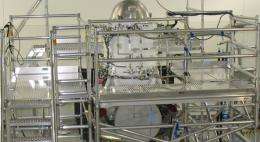WISE Is Chilling Out

(PhysOrg.com) -- Engineers are busy cooling the science instrument on NASA's Wide-field Infrared Survey Explorer, or WISE. The spacecraft is scheduled to blast into space from Vandenberg Air Force Base in California on Dec. 7, 2009. It will map the entire sky in infrared light, uncovering all sorts of hidden treasures -- everything from the coolest stars to dark asteroids and the most luminous galaxies.
To see infrared light from the cosmos, WISE must be chilled to out-of-this-world cold temperatures. This prevents the telescope from picking up its own infrared glow, or heat. A bottle-like chamber, called a cryostat, surrounds and cools the telescope and detectors. The cryostat will be filled with frozen hydrogen, which slowly evaporates away over a period of about 10 months -- enough time for WISE to scan the sky one-and-a-half times.
On Thursday, Oct. 29, engineers began the process of pumping hydrogen gas into the cryostat's two tanks, one after the other. Surrounding pipes filled with liquid helium are used to cool and condense the hydrogen gas to a liquid. Once a tank is filled with liquid hydrogen, the liquid helium flow is turned up. This freezes the hydrogen solid. The engineers control and monitor the process round-the-clock with the help of a scaffolding structure built around WISE.
"We want the hydrogen gas to convert to a liquid before it freezes so that it fills up the tanks from bottom to top, allowing us know where the hydrogen is," said John Elwell, the project manager for the science instrument on WISE. Elwell and his team, from the Space Dynamics Laboratory in Logan, Utah, are responsible for building, testing and cooling the instrument.
Ultimately, the hydrogen will be cooled down to below a mere 7 Kelvin, or minus 266 degrees Celsius (minus 447 degrees Fahrenheit). That's just 7 degrees Celsius above absolute zero -- the coldest temperature theoretically attainable. The coldest of WISE's detectors will operate at below 8 degrees Kelvin (minus 265 degrees Celsius or minus 445 degrees Fahrenheit).
Liquid helium will continue to be piped around the cryostat until 19 hours before launch. At that point, WISE will be perfectly chilled out and ready to see our universe's true infrared colors.
Provided by JPL/NASA (news : web)




















